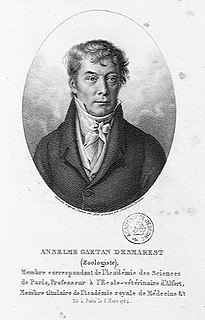
Paleobotany, which is also spelled as palaeobotany, is the branch of botany dealing with the recovery and identification of plant remains from geological contexts, and their use for the biological reconstruction of past environments (paleogeography), and the evolutionary history of plants, with a bearing upon the evolution of life in general. A synonym is paleophytology. It is a component of paleontology and paleobiology. The prefix palaeo- means "ancient, old", and is derived from the Greek adjective παλαιός, palaios. Paleobotany includes the study of terrestrial plant fossils, as well as the study of prehistoric marine photoautotrophs, such as photosynthetic algae, seaweeds or kelp. A closely related field is palynology, which is the study of fossilized and extant spores and pollen.

Adolphe-Théodore Brongniart FRS FRSE FGS was a French botanist. He was the son of the geologist Alexandre Brongniart and grandson of the architect, Alexandre-Théodore Brongniart. Brongniart's pioneering work on the relationships between extinct and existing plants has earned him the title of father of paleobotany. His major work on plant fossils was his Histoire des végétaux fossiles (1828–37). He wrote his dissertation on the Buckthorn family (Rhamnaceae), an extant family of flowering plants, and worked at the Muséum national d'Histoire naturelle in Paris until his death. In 1851, he was elected a foreign member of the Royal Swedish Academy of Sciences. This botanist is denoted by the author abbreviation Brongn. when citing a botanical name.

Equisetales is an order of subclass Equisetidae with only one living family, Equisetaceae, containing the genus Equisetum (horsetails).

Anselme Gaëtan Desmarest was a French zoologist and author. He was the son of Nicolas Desmarest and father of Eugène Anselme Sébastien Léon Desmarest. Desmarest was a disciple of Georges Cuvier and Alexandre Brongniart, and in 1815, he succeeded Pierre André Latreille to the professorship of zoology at the École nationale vétérinaire d'Alfort. He was elected to the American Philosophical Society in 1819 and to the Académie Nationale de Médecine in 1820.

Alexandre-Théodore Brongniart was a prominent French architect.

Alexandre Brongniart was a French chemist, mineralogist, geologist, paleontologist, and zoologist, who collaborated with Georges Cuvier on a study of the geology of the region around Paris. Observing fossil content as well as lithology in sequences, he classified Tertiary formations and was responsible for defining 19th century geological studies as a subject of science by assembling observations and classifications.

Sigillaria is a genus of extinct, spore-bearing, arborescent (tree-like) plants. It was a lycopodiophyte, and is related to the lycopsids, or club-mosses, but even more closely to quillworts, as was its associate Lepidodendron.
The Protorthoptera are an extinct order of Palaeozoic insects, and represent a wastebasket taxon and paraphyletic assemblage of basal neoptera. They appear during the Middle Carboniferous, making them among the earliest known winged insects in the fossil record. Pronotal lobes may be expanded to form a shield. The group includes the ancestors of all other polyneopterous insects.

Euronext Paris is France's securities market, formerly known as the Paris Bourse, which merged with the Amsterdam, Lisbon, and Brussels exchanges in September 2000 to form Euronext NV. As of 2022, the 795 companies listed had a combined market capitalization of over US$4.5 trillion. Euronext Paris, the French branch of Euronext, is Europe's second-largest stock exchange market, behind the London Stock Exchange.

The Palais Brongniart housed the historical Paris stock exchange. It is located at the Place de la Bourse, in the II arrondissement, Paris.

Étienne Éloi Labarre (1764–1833) was a French architect.

Sèvres – Cité de la céramique is a French national ceramics museum located at the Place de la Manufacture, Sèvres, Hauts-de-Seine, a suburb of Paris, France. It was created in January 2010, from the merger of the Musée national de Céramique-Sèvres and the Manufacture nationale de Sèvres. The museum is open daily except Tuesday; an admission fee is charged. Access to the museum by public transportation is available from Tramway d'Île-de-France station Musée de Sèvres on Tramway T2, and by Paris Métro station Pont de Sèvres on Line 9.

Jean Antoine Arthur Gris was a French botanist who was a native of Châtillon-sur-Seine, in the department of Côte-d'Or.

Monura is an extinct suborder of wingless insects in the order Archaeognatha. They resembled their modern relatives, the silverfish, and had a single lengthy filament projecting from the end of the abdomen. They also had a pair of leg-like cerci and some non-ambulatory abdominal appendages. The largest specimens reached 30 millimetres (1.2 in) or more, not counting the length of the filament.

Tympanotonos is a genus of snail living in brackish water, a gastropod mollusk in the family Potamididae.
The genus Phyllotheca was created in 1828, when Brongniart described the type species Phyllotheca australis coming from Hawkesbury River, Australia.

Zamites is a genus of fossil tree known from the Mesozoic of North America, Europe and India through the Eocene of North America. It was erected as a form taxon for leaves that superficially resembled the extant cycad Zamia, however it is now believed to belong to a similar but phylogenetically different group, the cyacadeoids (Bennettitales). The fronds are linear or lanceolate in shape, and pinnately compound, with pinnae with parallel veins and smooth margins, and symmetrical and constricted at the base where they are attached obliquely to the upper surface of the rachis. It has been interpreted as a Bennettitalean plant in the family Williamsoniaceae.
Events from the year 1770 in France

Conocephalinae, meaning "conical head", is an Orthopteran subfamily in the family Tettigoniidae.

Homoioptera is an extinct genus of winged insects from the Upper Carboniferous of Europe.
















